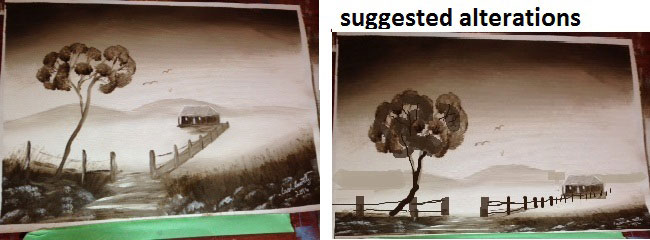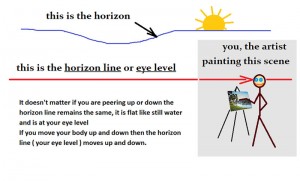Horizon Line in Painting Mistakes
Best explanation of horizon line.
What is the horizon line in a painting? It is the eye level. Not your eye level but the eye level on the painting.
The height of each item must be placed at the correct height on the horizon line.
The very first thing that you need to do when starting a painting is to decide at what height on your canvas is the eye level.
Read this paragraph carefully.
Imagine if you are in still water up to your eyes, the surface of the water is a perfect straight line, that is the eye level. That is also called the horizon line. It doesn’t matter if you look up or down, the water line (eye level, horizon line) will stay there. Think of the horizon line in your painting as the perfectly level plain at the eye level. Your eye level, if you were there looking at the actual scene.
Putting this eye level too high.

Putting this eye level too high up the canvas is a most often problem with beginners paintings.
The eye level is usually the distant ground level.
If you paint the eye level too high the water in the painting may look like it is standing up. Or you may feel like you are looking at the scene from up in the trees.
Paintings with the eye level at the correct height look better and sell better.
You should make the viewer feel like they are there and not looking down or up at the scene.
Every time you look at something in the real world there is a level of sight that can be called the EYE LEVEL and it doesn’t matter if you are sitting, laying down or standing on your head the eye level is the level-plain at the height of your eye ball.
The horizon has nothing to do with the horizon line, but in flat desert and ocean scenes the horizon and eye level are often the same.
With still water scenes it is easier to find the view point, or eye level because water establishes a flat and level area and the viewing height that a scene is being painted from can be estimated by imagining the eye height on the opposite bank.
Anything coming towards you, a building or a footpath or a bird or a cat is either above the eye level or below the eye level or it might be on the horizon line.
Got the idea? eye level and horizon line mean exactly the same thing
It doesn’t matter if you are peering up or down the eye level remains the same, it is flat like still water.
If you move your body up and down then your eye level moves up and down.
On your paintings you must have one eye level
(you can’t see over a fence and under the house while looking at a mountain which goes higher than the tree) – some people do!
This is a silent movie.
Why is a high horizon line not good in most landscape paintings?
In a normal situation a person views scenery with their feet on the ground and they look straight forward. That gives about two thirds of the view as sky area, above the horizon line.
If the horizon line is lifted well up the canvas then this often looks like the scene was viewed from off the ground ( a birds eye view ). In some paintings it might look like the landscape in front rises up to meet the horizon line as looking into a valley.
With a scene containing flat water, the landscape must stay in perspective with the flat water. This can become confusing and often results in the water looking like it is sloping away and uphill if the horizon line is too high.
This high distant eye level mistake is common where the horizon line is the opposite river bank.
The higher the eye level the closer the background looks. Therefore to get good depth in a landscape painting it is better to have a low eye level. If you are painting from the top of a mountain and wish to include the valley floor, then the eye level might be in the distant sky.